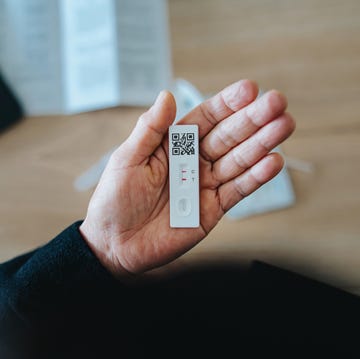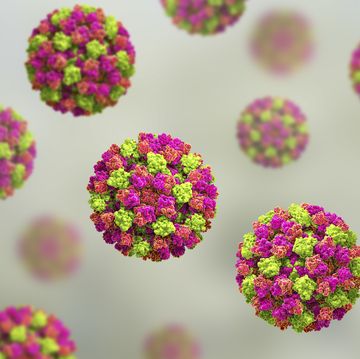It’s well known that women frequently fall victim to misdiagnosis in the medical field due to doctors who may overlook important symptoms in cases of both mental and physical health. This happens due to medical bias—and the fact that women sometimes experience conditions, like autism spectrum disorder (ASD), differently from men.
Like many health conditions, ASD looks a bit different on everyone—and girls and women are diagnosed less overall, though it’s not a “male” condition.
This difference in presentation between genders is thought to explain why “prevalence rates are heavily skewed towards males compared to females, with boys are four times more likely to be diagnosed than girls,” explains Rachel Earl, Ph.D., Clinical Psychologist, University of Washington/Seattle Children’s Hospital. It also likely explains why girls are more commonly diagnosed later in life than boys. “Lack of female representation in autism research is also a longstanding issue, leading to better understanding of autism symptoms in males compared to females. We now understand that autism is indeed observed in women and girls, but that symptoms may look slightly different,” Earl reveals.
This gender disparity explains why “ASD has been primarily viewed as a male condition,” says Wendela Whitcomb Marsh, M.A., R.S.D, B.C.B.A., award-winning author and adult autism assessment specialist.
First, what is autism spectrum disorder?
Let’s backtrack: What exactly is autism? “Autism spectrum disorder (ASD) is characterized by differences in social communication and the presence of repetitive and focused interests and behaviors,” says Earl. It is important to note as the name describes, that ASD is a spectrum disorder, meaning that symptoms will vary in presentation and severity between individuals.
How is autism diagnosed?
So, how is such a variable disorder diagnosed? “Most people with autism are diagnosed as children,” notes Susan P. Sherkow, M.D., Director of the not-for-profit Sherkow Center for Child Development and Autism Spectrum Disorder and principal author of Autism Spectrum Disorder: Perspectives from Psychoanalysis and Neuroscience. ”When you look at a higher functioning or older person with autism, it is sometimes harder to pick out those pieces that are seen very easily in a two-year old.”
Autism is diagnosed by clinical providers with specialized training, Earl explains. “An autism evaluation generally involves an extensive interview about early development and current communication, social skills, and behaviors along with a structured behavioral observation.” These evaluations are sometimes part of a process involving multiple professionals to accurately understand the various and individual signs and symptoms.
What are the symptoms of autism?
According to Dr. Sherkow, common symptoms related to autism include social and behavioral inhibitions.
Social symptoms
Forming relationships and communicating with others can often be a challenge for those with autism, resulting in an array of symptoms that can include:
- Gaze aversion
- Language inhibition
- Resistance to conversation
- Difficulty expressing and reading emotions
- Sensitivity to change
Behavioral symptoms
Idiosyncratic, or unique behaviors are common in those with autism which can include:
- Sensory sensitivity
- Stimming
- Rigidity
- Repetitive and avoidant acts
- Fixation on specific objects or subject matter
How autism symptoms present differently in women
The symptoms related to autism are generally the same for girls and women as for boys and men, however there are key differences in the degree and display of symptoms. Girls and women may present more internalizing behaviors (i.e., social anxiety, depression) and fewer externalizing behaviors (i.e. hyperactivity, impulsivity) than boys and men with autism. Girls may show more subtle social differences early in development while “puberty onset may exacerbate symptoms in girls with autism that were previously milder,” including sensory processing differences, emotion regulation challenges, and difficulties with relationships, Earl explains. These key differences play an important role in why women and girls are likely to be under-diagnosed, misdiagnosed, or diagnosed later in life.
Another notable reason for difficulties in diagnosing girls and women is that providers may be biased towards a male prototype of ASD and thus miss early signs of autism in girls. “Autism is like coloring something that's already there,” Dr. Sherkow notes. “So that is important for understanding women.”
Research also shows that girls and women more likely to mask their symptoms, contributing to decreased diagnosis. “Masking in the context of autism refers to the emotionally, mentally, and even physically taxing experience of adjusting one’s behavior to fit the expectation of a neurotypical society,” according to Earl. “It is an important consideration for all autistic individuals and may be a particular experience of women and girls on the spectrum.” Girls and women with autism mask in a variety of ways by using social scripts to blend in, and compared to boys and men are generally “much better at masking, imitating others, and keeping a low profile,” says Marsh.
Why is an autism diagnosis important
Receiving a diagnosis can be extremely powerful for individuals with autism by lending a sense of pride and understanding in themselves. Diagnosis can be helpful for a variety of reasons, including connecting the individual with resources such as therapy, educational accommodations, and community support. Additionally, Earl says, “It can explain someone’s differences in social communication and behavior which can inform an autistic person’s identity and help others in their life accommodate and support them.” Receiving a diagnosis can be especially validating, allowing the individual to understand the way they have been feeling throughout their lives.
How can we better support women with autism
The lack of diagnosis and representation for women and girls with autism can prolong suffering and be confusing for many. “Better support is needed for women with autism, both clinically and in their communities,” Earl notes. “Amplifying the voices of autistic girls and women is critical to understanding the female experience of autism and tailoring support and resources.”
“The most important thing we can do is to listen, respect, and believe girls and women. If she says, ‘I think I might be autistic,’ I hope her doctor, therapist, family, or friends will take a moment to consider that,” Marsh says.
If you or a loved one seek resources dedicated to helping women with autism there are many options available. The Autistic Women and Nonbinary Network (AWN) is an organization dedicated to providing support, community, and resources for women and gender-nonconforming with autism. There is also an abundance of literature available that offers insight in the experience of women with autism, like Women and Girls with Autism Spectrum Disorder and Thinking in Pictures: My Life with Autism.

Shannen Zitz is an Assistant Editor at Prevention, where she covers all things lifestyle, wellness, beauty, and relationships. Previously the Editorial Assistant at Prevention, she graduated from the State University of New York at Cortland with a bachelor's degree in English. If she’s not reading or writing, you can probably find her frequenting the skincare and makeup forums on Reddit or hogging the squat rack at the gym.













